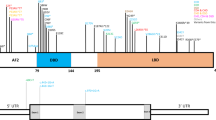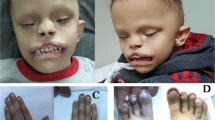Abstract
Prader-Willi syndrome (PWS) is a neurobehavioural disorder characterized by neonatal respiratory depression, hypotonia and failure to thrive in infancy, followed by hyperphagia and obesity among other symptoms1,2. PWS is caused by the loss of one or more paternally expressed genes on chromosome 15q11–q13, which can be due to gene deletions, maternal uniparental disomy or mutations disrupting the imprinting mechanism. Imprinted genes mapped to this region include SNRPN (refs 3 ,4), ZNF127 ( ref. 5), IPW (ref. 6) and NDN (which encodes the DNA-binding protein necdin; refs 7,8,9,10). The mouse homologues of these genes map to mouse chromosome 7 in a region syntenic with human chromosome 15q11–q13 (refs 7,11). Imprinting of the human genes is under the control of an imprinting center (IC), a long-range, cis-acting element located in the 5′ region of SNRPN (ref. 12). A related control element was isolated in the mouse Snrpn genomic region which, when deleted on the paternally inherited chromosome, resulted in the loss of expression of all four genes and early post-natal lethality13. To determine the possible contribution of Ndn to the PWS phenotype, we generated Ndn mutant mice. Heterozygous mice inheriting the mutated maternal allele were indistinguishable from their wild-type littermates. Mice carrying a paternally inherited Ndn deletion allele demonstrated early post-natal lethality. This is the first example of a single gene being responsible for phenotypes associated with PWS.
This is a preview of subscription content, access via your institution
Access options
Subscribe to this journal
Receive 12 print issues and online access
$209.00 per year
only $17.42 per issue
Buy this article
- Purchase on Springer Link
- Instant access to full article PDF
Prices may be subject to local taxes which are calculated during checkout




Similar content being viewed by others
References
Holm, V.A. et al. Prader-Willi syndrome: consensus diagnostic criteria. Pediatrics 91, 398–402 ( 1993).
Wharton, R.H. & Bresnan, M.J. Neonatal respiratory depression and delay in diagnosis in Prader-Willi syndrome. Dev. Med. Child. Neurol. 31, 231–236 ( 1989).
Leff, S.E. et al. Maternal imprinting of the mouse Snrpn gene and conserved linkage homology with the human Prader-Willi syndrome region. Nature Genet. 2, 259–264 ( 1992).
Ozcelik, T. et al. Small nuclear ribonucleoprotein polypeptide N (SNRPN), an expressed gene in the Prader-Willi syndrome critical region. Nature Genet. 2, 265–269 ( 1992).
Glenn, C.C. et al. Modification of 15q11–q13 DNA methylation imprints in unique Angelman and Prader-Willi patients. Hum. Mol. Genet. 2, 1377–1382 (1993).
Wevrick, R., Kerns, J.A. & Francke, U. Identification of a novel paternally expressed gene in the Prader-Willi syndrome region. Hum. Mol. Genet. 3, 1877–1882 (1994).
MacDonald, H.R. & Wevrick, R. The necdin gene is deleted in Prader-Willi syndrome and is imprinted in human and mouse. Hum. Mol. Genet. 6, 1873–1878 (1997).
Sutcliffe, J.S., Han, M., Christian, S.L. & Ledbetter, D.H. Neuronally-expressed necdin gene: an imprinted candidate gene in Prader-Willi syndrome. Lancet 350, 1520–1521 ( 1997).
Jay, P. et al. The human necdin gene, NDN, is maternally imprinted and located in the Prader-Willi syndrome chromosomal region. Nature Genet. 17, 357–361 ( 1997).
Nakada, Y., Taniura, H., Uetsuki, T., Inazawa, J. & Yoshikawa, K. The human chromosomal gene for necdin, a neuronal growth suppressor, in the Prader-Willi syndrome deletion region. Gene 213, 65–72 ( 1998).
Watrin, F. et al. The mouse necdin gene is expressed from the paternal allele only and lies in the 7C region of the mouse chromosome 7, a region of conserved synteny to the human Prader-Willi syndrome region. Eur. J. Hum. Genet. 5, 324–332 ( 1997).
Horsthemke, B. Structure and function of the human chromosome 15 imprinting center. J. Cell Physiol. 173, 237–241 (1997).
Yang, T. et al. A mouse model for Prader-Willi syndrome imprinting-centre mutations. Nature Genet. 19, 25–31 (1998).
Tsai, T.F., Armstrong, D. & Beaudet, A.L. Necdin-deficient mice do not show lethality or the obesity and infertility of Prader-Willi syndrome. Nature Genet. 22, 15–16 ( 1999).
Olson, E.N., Arnold, H.H., Rigby, P.W. & Wold, B.J. Know your neighbors: three phenotypes in null mutants of the myogenic bHLH gene MRF4. Cell 85, 1–4 (1996).
Zakany, J., Gerard, M., Favier, B. & Duboule, D. Deletion of a HoxD enhancer induces transcriptional heterochrony leading to transposition of the sacrum. EMBO J. 16, 4393– 4402 (1997).
Wagner, K.U. et al. Cre-mediated gene deletion in the mammary gland. Nucleic Acids Res. 25, 4323–4330 (1997).
Aizawa, T., Maruyama, K., Kondo, H. & Yoshikawa, K. Expression of necdin, an embryonal carcinoma-derived nuclear protein, in developing mouse brain. Brain Res. Dev. Brain Res. 68, 265 –274 (1992).
Hayashi, Y., Matsuyama, K., Takagi, K., Sugiura, H. & Yoshikawa, K. Arrest of cell growth by necdin, a nuclear protein expressed in postmitotic neurons. Biochem. Biophys. Res. Commun. 213, 317–324 (1995).
Uetsuki, T., Takagi, K., Sugiura, H. & Yoshikawa, K. Structure and expression of the mouse necdin gene. Identification of a postmitotic neuron-restrictive core promoter. J. Biol. Chem. 271, 918– 924 (1996).
Taniura, H., Taniguchi, N., Hara, M. & Yoshikawa, K. Necdin, a postmitotic neuron-specific growth suppressor, interacts with viral transforming proteins and cellular transcription factor E2F1. J. Biol. Chem. 273, 720–728 (1998).
Jong, M.T. et al. Imprinting of a RING zinc-finger encoding gene in the mouse chromosome region homologous to the Prader-Willi syndrome genetic region. Hum. Mol. Genet. 8, 795– 803 (1999).
Acknowledgements
We thank T. Shatzer and L. Sewel for animal care; T. Sullivan for technical assistance; K.U. Wagner for the Cre expressing mice; L. Tessarollo for mice and discussion; J. Ward for help in histopathology; A. Wang for reading the manuscript; and members of the lab for discussions. This research was sponsored by the National Cancer Institute, DHHS, under contract with ABL. R.W. was supported by the Medical Research Council of Canada and a Basil O'Connor Scholarship from the March of Dimes.
Author information
Authors and Affiliations
Corresponding author
Rights and permissions
About this article
Cite this article
Gérard, M., Hernandez, L., Wevrick, R. et al. Disruption of the mouse necdin gene results in early post-natal lethality . Nat Genet 23, 199–202 (1999). https://doi.org/10.1038/13828
Received:
Accepted:
Issue Date:
DOI: https://doi.org/10.1038/13828
This article is cited by
-
Firing activity of locus coeruleus noradrenergic neurons decreases in necdin-deficient mice, an animal model of Prader–Willi syndrome
Journal of Neurodevelopmental Disorders (2020)
-
Know Your Model: When parental origin matters
Lab Animal (2020)
-
Towards Functional Annotation of the Preimplantation Transcriptome: An RNAi Screen in Mammalian Embryos
Scientific Reports (2016)
-
Promotion of mitochondrial biogenesis by necdin protects neurons against mitochondrial insults
Nature Communications (2016)
-
What does genetics tell us about imprinting and the placenta connection?
Cellular and Molecular Life Sciences (2015)



